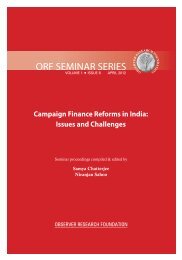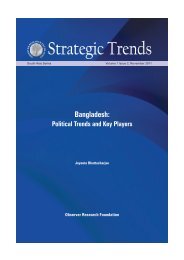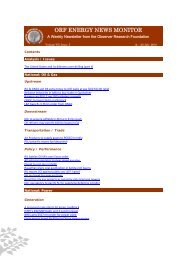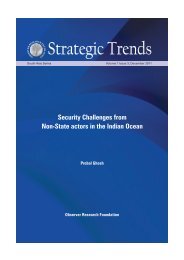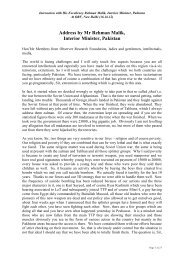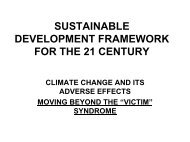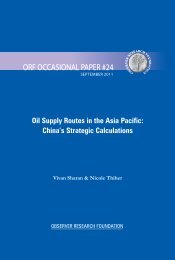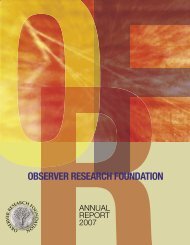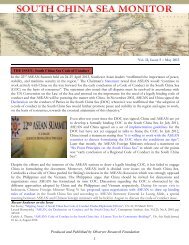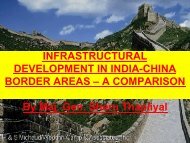Affirmative Action in Private Sector in Malaysia - Observer Research ...
Affirmative Action in Private Sector in Malaysia - Observer Research ...
Affirmative Action in Private Sector in Malaysia - Observer Research ...
Create successful ePaper yourself
Turn your PDF publications into a flip-book with our unique Google optimized e-Paper software.
What is probably more useful takeaway from the <strong>Malaysia</strong>n experience is its focus and<br />
strategies <strong>in</strong> <strong>in</strong>vest<strong>in</strong>g on build<strong>in</strong>g massive human resource capacities among Bumiputeras <strong>in</strong><br />
order to enable them participate <strong>in</strong> the modern sectors of economy. As has been noted earlier,<br />
the state and its agencies mounted an unprecedented amount of resources to have more<br />
Bumpiputeras <strong>in</strong> higher education particularly <strong>in</strong> technical and high skilled professions. Apart<br />
from expand<strong>in</strong>g access to higher education, the state spent generously to br<strong>in</strong>g up new<br />
<strong>in</strong>stitutions, provided hundreds of scholarships for overseas education and tra<strong>in</strong><strong>in</strong>g for<br />
Bumiputeras apart from giv<strong>in</strong>g them critical launch<strong>in</strong>g pad to set up their bus<strong>in</strong>esses and so<br />
on. Millions of Bumiputeras entered private sector through education and tra<strong>in</strong><strong>in</strong>g route and<br />
with<strong>in</strong> just two decades could change the previous workforce composition to their advantage.<br />
Of course, there are issues like many of them are placed <strong>in</strong> lower end jobs and they are yet to<br />
massively get <strong>in</strong>to top technical and managerial positions. But this achievement is no small<br />
feat. And if the current trends are any true, more and more qualified Bumiputeras are now<br />
gett<strong>in</strong>g <strong>in</strong> big ways to top private sector positions. In short, <strong>Malaysia</strong>’s most endur<strong>in</strong>g<br />
achievement is probably its emphasis on creat<strong>in</strong>g a large pool of eligible Bumiputeras than<br />
the forced equity restructur<strong>in</strong>g and so on. It is here probably India can draw much lessons<br />
while design<strong>in</strong>g affirmative action programmes for its disadvantaged groups which has a<br />
negligible presence <strong>in</strong> grow<strong>in</strong>g private sector. Therefore, human resource route is the key to<br />
aid disadvantaged sections to f<strong>in</strong>d greater representation <strong>in</strong> private sector.<br />
To sum up, the preced<strong>in</strong>g analyses po<strong>in</strong>t to the preem<strong>in</strong>ent role of the state <strong>in</strong> terms of<br />
facilitat<strong>in</strong>g selective <strong>in</strong>terventions <strong>in</strong> private sector and most practical way of do<strong>in</strong>g this<br />
would be through human resource route than blanket quota. And given the fact that the<br />
country is go<strong>in</strong>g through a high growth trajectory, it can afford to direct substantial resources<br />
and <strong>in</strong> some cases can persuade private sector players to come out with <strong>in</strong>novative<br />
affirmative methods/tools and surely avoid quota fixation as <strong>Malaysia</strong> had employed. In<br />
short, <strong>Malaysia</strong>n experience certa<strong>in</strong>ly expands the affirmative choices by offer<strong>in</strong>g more<br />
menus for thoughts to make private sector more <strong>in</strong>clusive than it looks today.<br />
REFERENCES<br />
Chandra, Muzzafar. 1986. <strong>Malaysia</strong>: Islamic Resurgence and the Question of Development,<br />
Sojourn 1(1).<br />
Chee, Peng Lim, et al, 1979. A Study of small entrepreneurs and Entrepreneurial Development Programmes<br />
<strong>in</strong> <strong>Malaysia</strong>, KL: University of Malaya Press<br />
Crouch, Harold. (1996). Government and society <strong>in</strong> <strong>Malaysia</strong>. Ithaca, NY: Cornell University Press.<br />
------, (2001). Manag<strong>in</strong>g Ethnic Tensions through <strong>Affirmative</strong> <strong>Action</strong>: The <strong>Malaysia</strong>n experience.<br />
<strong>in</strong> N. J. Colletta, T. G. Lim,&A.Kelles-Viitanen (Eds.), Social cohesion and conflict prevention <strong>in</strong> Asia<br />
(pp. 225-262). Wash<strong>in</strong>gton, DC: The World Bank.<br />
Chua, A. L. (2000). Free-market democracy: Indonesia and the problems fac<strong>in</strong>g neoliberal reform. A Council<br />
on Foreign Relations Paper. New York: The Council on Foreign Relations.<br />
Economic Plann<strong>in</strong>g Unit. (EPU). (1991). The second outl<strong>in</strong>e perspective plan 1991-2000. Kuala



